































Before employing artificial intelligence (AI) to find job candidates, Southwest Airlines had no definitive way to track the success of the company's email and website hiring campaigns. The airline also couldn't queue up potential applicants who'd logged into a job listings page and left before an applicable position had been posted.
Since it began using an AI-enabled hiring platform from tech firm Phenom, the airline now has "a warm pipeline of candidates" it can draw on whenever jobs opportunities arise, according to Kelby Tansey, manager for recruitment marketing at Southwest Airlines.
Tansey said the airline can now reach out to "passive" job candidates who came to Southwest but couldn't find an open position at the time.
"We'll drive them into certain pipelines within the Phenom platform so we can capture their resume, their skills, and note some of those candidates and then let them know when the job opens up," Tansey said.
Southwest is among a growing number of organizations turning to AI-based tools to identify potential job candidates, schedule interviews, and reduce the overall time recruiters and hiring managers spend on those tasks.
From 35% to 45% of companies are expected to use AI-based talent acquisition software and services to help select and interview job prospects this year, according to recent studies.
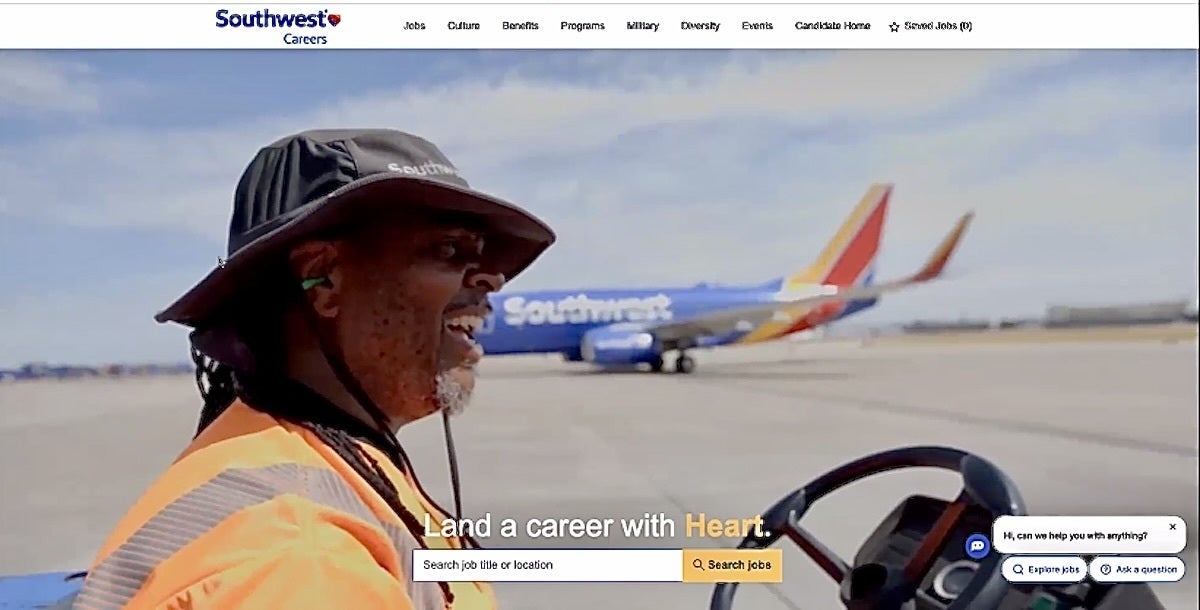 Southwest Airlines
Southwest Airlines Southwest Airline's recruitment site powered by Phenom's AI software.
Nearly three in four organizations boosted their purchases of talent acquisition technology in 2022 and 70% plan to continue investing this year - even if a recession arrives - according to a survey by enterprise hiring platform Modern Hire.
Forrester Research Principal Analyst Betsy Summers said she's been getting more inquiries from clients about AI recruiting platforms.
"It has touched a nerve in the HR and recruiting world, promising to fix problems and frustrations that have been plaguing those teams - hard to decipher competency models, job descriptions that are vague or biased, increasing talent competition," Summers said.
The questions Summers gets about recruitment platforms go beyond talent acquisition and include "skills-as-a-service" technology that has "a huge potential impact on how organizations plan their workforce, develop them, how and where they allocate work, and how they grow and retain workers.
"It could be a game changer," Summers said.
Along with Phenom's SaaS-based Intelligent Talent Experience platform, other leading providers of AI-based talent acquisition software and services include Eightfold, Beamery, and Seekout - all of which perform skills inference and candidate-job matching. Other notable vendors include Clovers (with its recent acquisition of Talvista), HireVue, Pymetrics (recently acquired by Harver), and iCIMS, according to Forrester Research.
AI-based recruitment platforms can find "more diverse talent pools, and [offer] a more accurate approach to qualifying candidates by matching skills rather than on a job title match or other signal," said Forrester Principal Analyst Betsy Summers.
Some of the use cases for talent acquisition platforms are efficiency-oriented, since they're used for interview scheduling, managing the candidate application process, assisting recruiters with follow-ups, and managing the applicant pipeline. Other platforms also focus on bias mitigation such as adjusting language in job descriptions and candidate communications to be more inclusive. Still others include remote video capabilities that automate early interviews.
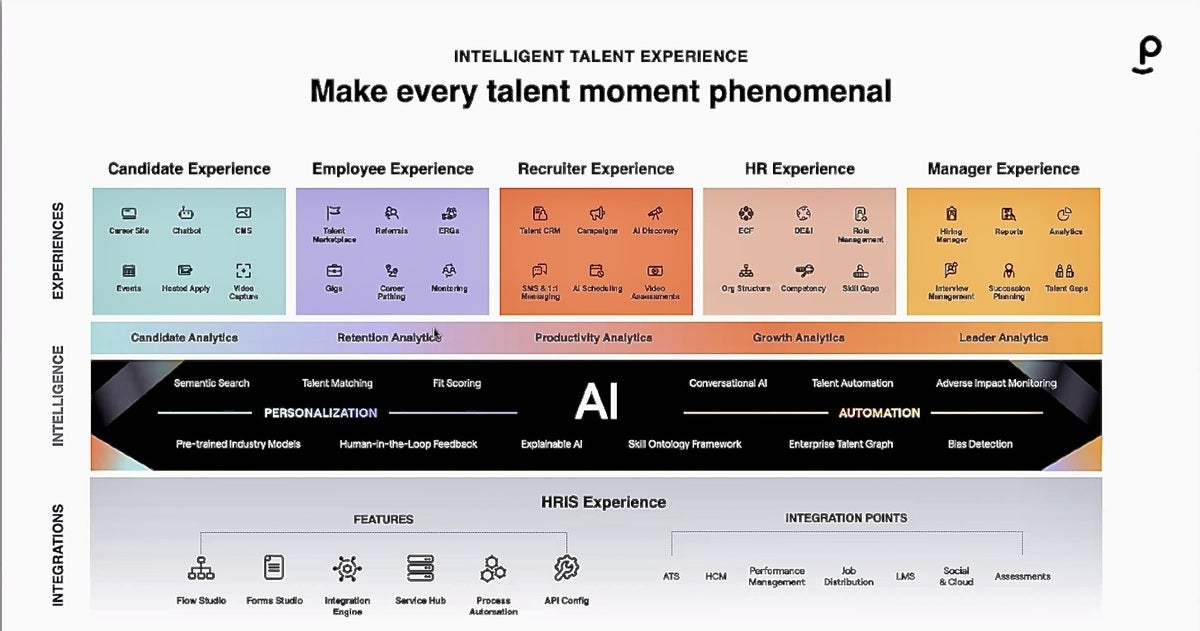 Phenom
Phenom HireVue's candidate interviewing software, for example, uses a natural language bot to conduct an interview and provide a transcript for hiring managers and recruiters. It also has a video component that records an interview, offering each would-be hire 30 seconds to prepare for each question, and up to three minutes to answer. The video is then sent to the hiring manager to view.
Talent acquisition software also often relies on "fits scoring," which uses specific metrics to match a job candidate's qualifications to a specific opening.
Bradley Cooper, director of IT at staffing firm SASR Workforce Solutions, said each recruiter in his company is responsible for hiring at least 360 people annually for various clients. In October 2021, SASR went live with Phenom's platform, which immediately provided efficiencies - among them, automatically matching candidates to job openings before a recruiter even contacted an applicant.
"When you work at our volume, you need tools to help get the candidates to you in a timely manner," Cooper said. "As soon as a job opportunity is available, we can make it known to the candidate, and that goes out to the job board Phenom has. Before that, it just wasn't a good recruiter or candidate experience."
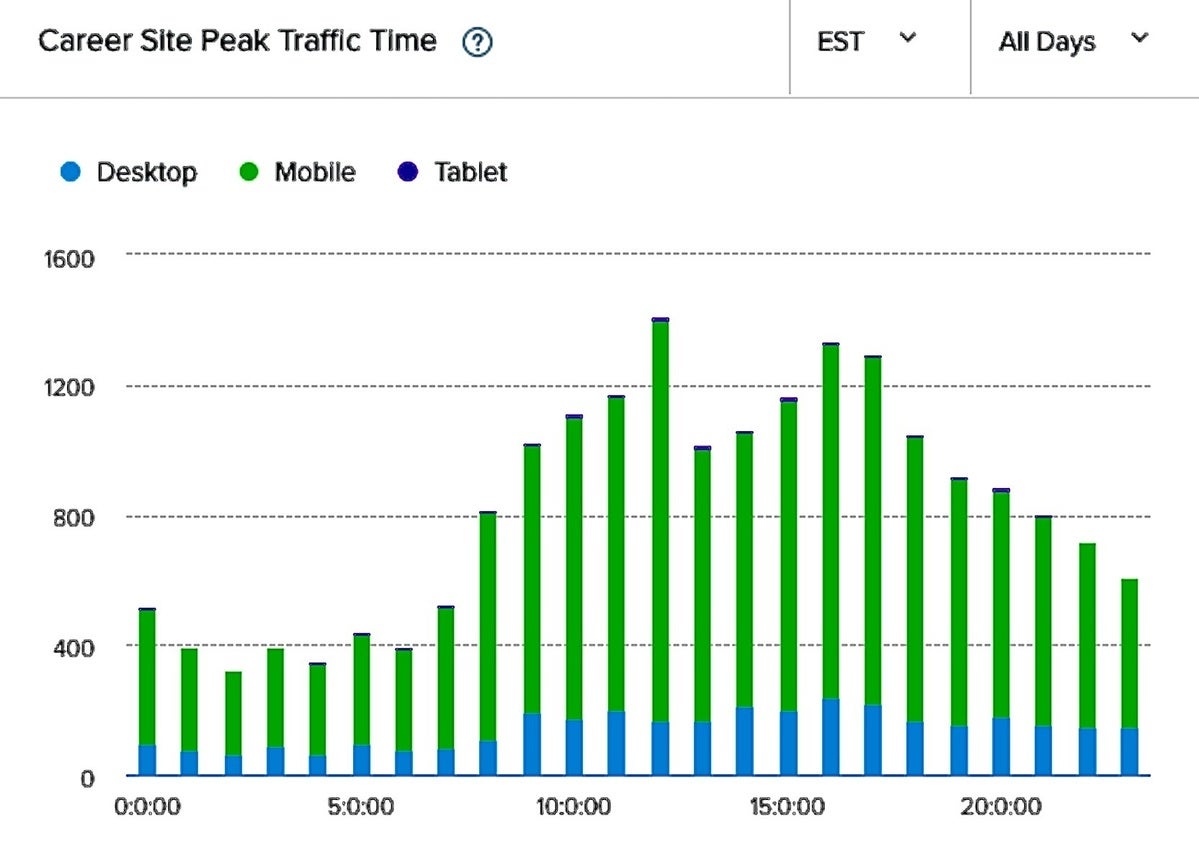 SASR
SASR An overview of when SASR sees the most traffic on its career site, which enables the staffing firm to use its dynamic and static list to create and deliver marketing campaigns during peak interaction times.
As soon as a job candidate begins the application process, Phenom's software begins building a profile of the person; if they're a good fit for a SASR client, it feeds the candidate to a recruiter who can interview them, make an offer, and start the onboarding process. If the prospect is not yet ready to accept an offer, Phenom's platform places them in a future candidate "talent community" or queue, allowing SASR to continue to contact them as opportunities come up.
SASR uses Phenom Hosted Apply, which provides a consistent experience for candidates, where they go from learning about a job to applying for it without having to leave the career site. Hosted Apply leverages API integrations Phenom made with third-party applicant tracking systems (ATS), and avoids the need for a candidate to get redirected to a separate ATS application process.
Phenom's platform also builds out a dynamic and static list of potential candidates. The former has candidates who are added or removed as they find work; the latter is a constant list of workers who can be accessed for seasonal or part-time positions. The lists can also be used to develop recruiting campaigns, Cooper said.
"Over time, as we add more candidates to the list, the AI will recognize the like candidates with the same skills and locations for opportunities, so that allows us to see the best fit upfront," Cooper said. "The really cool part about having a dynamic list is it allows you to target them for a specific opportunity, or if we do a specific campaign, we can curate that messaging to them through email or SMS to hit the correct touchpoints."
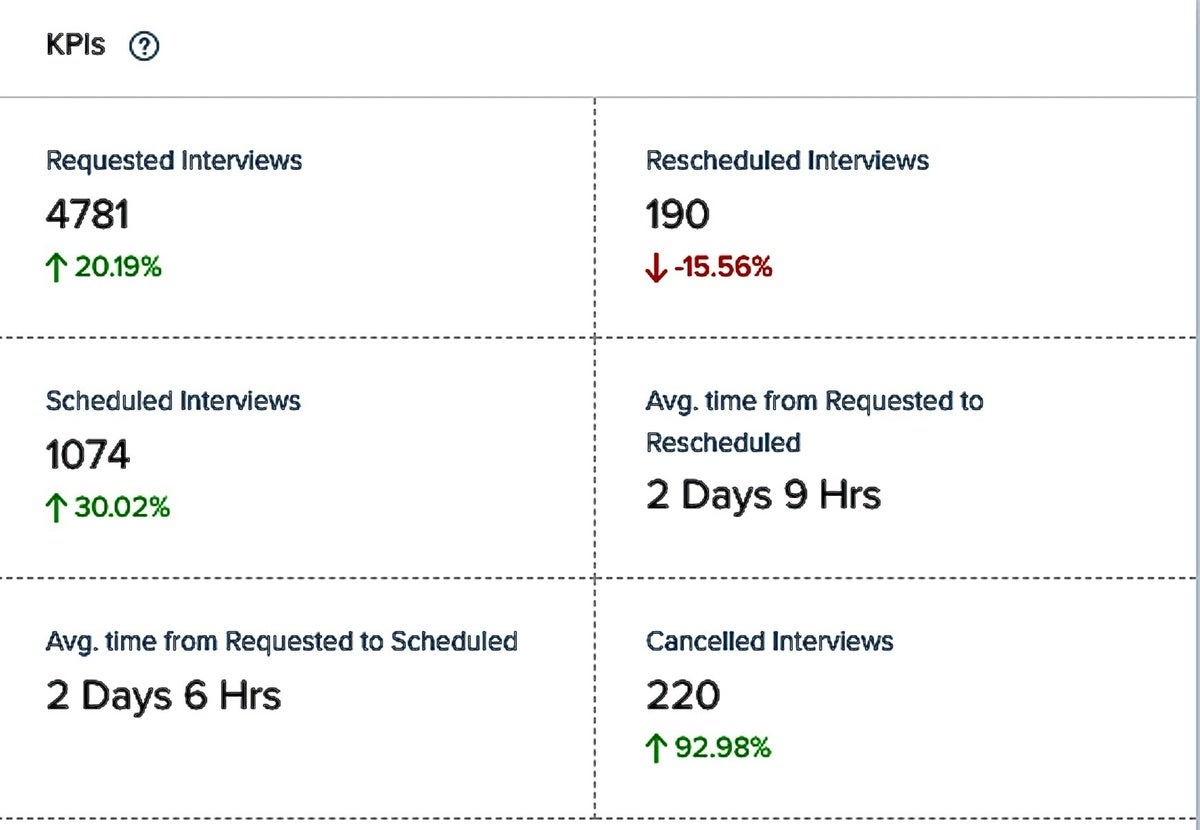 SASR
SASR This is a KPI roll up providing visibility on SASR's Job Seeker interviews. It's important that interviews happen quickly, as job seekers tend to lose interest if an interview is not scheduled within a few days of application.
The return on investment for an automated recruiting platform can be tremendous. One study funded by Phenom and performed by Forrester showed a 449% ROI over three years with a payback period of less than six months - equaling more than$24 million in savings and business benefits.
The study showed that, on average, the recruiting platforms saved hiring managers and recruiters 11 hours per week. The software also increased the number of hires and decreased costs of new-hire onboarding, training, and time to productivity.
Job recruiters at Southwest Airlines saw a 40% time savings when using Phenom's analytics tools to find candidates, automate scheduling and do video interviews.
"After we went live with Phenom's career site refresh in September, we saw a 25% increase in website engagement. That means more candidates are visiting more [job] pages," Tansey said. "From a hiring perspective, we're able to capture all candidate data in one place, follow up on leads, keep them nurtured and warm, and drive them to apply."
"If we were driving only leads to jobs only open now, we wouldn't be able to get the full value out of what we could do from an evergreen strategy...," Tansey said. "We're even able to engage at the campus level with kids who may be pursuing careers and keep them warm and bring them into our pipelines."
Another feature of talent acquisition services is the ability to uncover a candidate's "soft skills" including their ability to learn, work as a team player, be creative, or have empathy.
For example, AI-firm Paradox has bot software named "Olivia" that's used, among other tools, to automate hiring for companies such as McDonalds, Speedway, Lowe's and American Eagle. Paradox also acquired Traitify, whose software assesses a candidate based on five metrics: openness, conscientiousness, extraversion, agreeableness, and neuroticism. Candidates are given a test that takes about 10 minutes and includes images the user responds to by selecting either "me" or "not me".
Chatbots are typically employed by recruitment platforms to engage job seekers and ask them about their interests and skills; the bots can then present candidates with open positions for which they're most qualified to apply.
For example, Phenom's chatbot allows job seekers to peruse various markets, such as engineering, marketing, sales, and data science and machine learning. It then asks questions such as, "Ae you willing to relocate? and "How many years and specific experience do you have?" Once the queries are completed, the chatbot presents open positions the candidate can apply for.
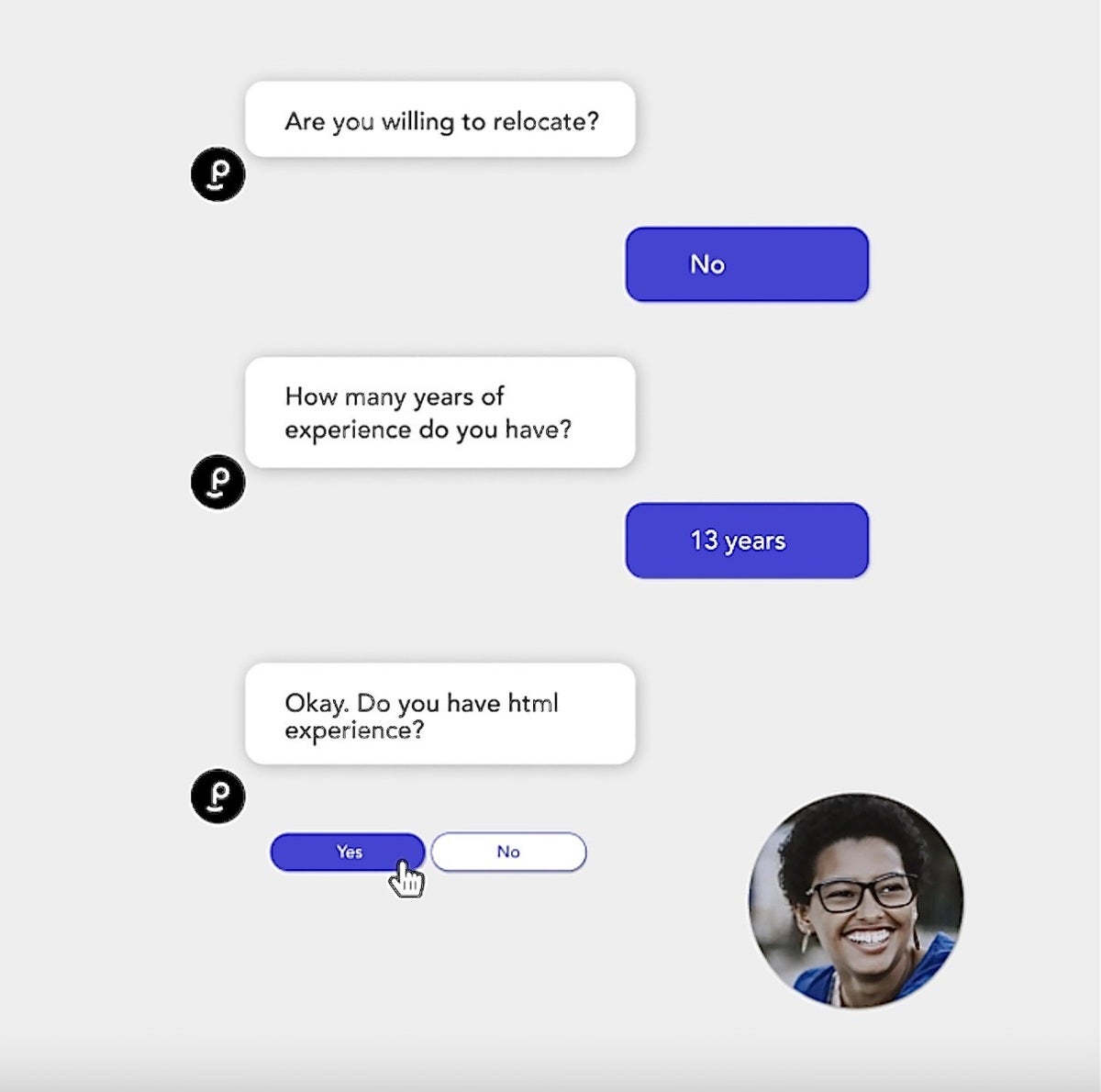 Phenom
Phenom Phenom's chatbot in action.
Allyn Bailey, who spent 11 years as an HR recruitment executive at Intel, cautioned against becoming too dependent on chatbots because they may contain unintentional biases, leading to discrimination in the hiring process. Basically, the chatbot is only as good as the developers who created it.
"So, while ChatGPT can streamline the job application process, it's best used as a supplement to traditional methods of evaluating candidates. You still need that human interaction and relationship building," said Bailey, now the executive director of "hiring success" for talent acquisition platform SmartRecruiters. "And don't forget to be mindful of the potential dangers and take steps to mitigate them."
ChatGPT, and other AI-based tools, can only provide pre-written responses to candidates, and they may not accurately reflect that person's unique skills, personality, and communication abilities. "That human touch is so important in the hiring process, and you don't want to lose that," Bailey said.
Forrester Research's Summers agreed, saying AI ideally should qualify more candidates into the pipeline than qualifying them out. AI should also help mitigate natural human bias in qualifying and selecting talent, not amplify it.
"Still fresh in our memory are stories about AI perpetuating bias in their qualification algorithm," Summers said. "And in the case of interview analysis, AI not trained on women, people of color, and non-native English speakers can misread facial and vocal cues to make the wrong call about qualified candidates."
Overall, however, sentiment about AI's impact on organizations is positive, according to Forrester's own survey data; 74% of respondents reported AI had a positive impact and 25% said the impact was "neutral."
Summers also cautioned that the regulatory environment is heating up for vendors and organizations deploying AI for recruitment and HR use cases. Those regulations are looking to protect candidates and employees from potentially harmful or biased practices. For example, the Organization for Economic Co-operation and Development tracks over 800 policies concerning AI around the world.
In HR, there is also a skills and confidence gap about AI that needs to be addressed. In 2021, only 19% of HR leaders were confident in their team's AI capabilities, Summers said.
To protect candidates and companies, it's imperative that organizations increase skills around AI management, establish ethical and responsible AI guidelines and resources for their employees and broader stakeholders, and vet their ecosystem for ethical and responsible AI practices, according to Summers.
"The good news is that 80% of our survey respondents report that their organization observes and evaluates data and data products against AI responsibility, outcomes, compliance, and protection well or very well," Summers said.
 Etiquetas calientes:
Inteligencia Artificial
5G
Chatbots
trabajo
Carreras profesionales
hri
Etiquetas calientes:
Inteligencia Artificial
5G
Chatbots
trabajo
Carreras profesionales
hri